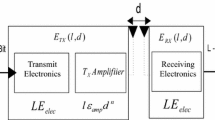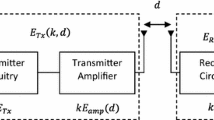Abstract
Hierarchical architecture is an effective scheme to make wireless sensor networks (WSNs) scalable and energy-efficient. Clustering the sensor nodes is a well-known two-layered architecture suitable for WSNs and has been extensively explored for different purposes and applications. In this paper a novel clustering approach called the adaptive competition-based clustering approach (ACCA) is proposed for WSNs. Selecting the cluster heads in the proposed ACCA is performed based upon a hybrid of local competition and the distances among the cluster heads. First, by the new proposed competition scheme, the nodes which are with the high residual energy and closer to the centre of the density of the nodes are elected and form an initial set of cluster head candidates. Then the candidates with suitable distances to other neighbor candidates are elected as the cluster heads. The proposed algorithm is fast with a low time and message complexity. It offers a longer lifetime for the networks, and at the same time, a proper level of fault tolerance. The proposed ACCA is simple enough to be implemented in real systems. Different simulation experiments are performed on different states and the algorithm is compared with some well-known and related clustering approaches. The experiments suggest that in terms of longevity and fault-tolerance, ACCA outperforms the well-known and relevant clustering protocols LEACH, HEED, and EECABN.















Similar content being viewed by others
Explore related subjects
Discover the latest articles, news and stories from top researchers in related subjects.References
Abbasi, A., & Younis, M. (2007). A survey on clustering algorithms for wireless sensor networks. Computer Communications, 30(14–15), 2826–2841.
Afsar, M., & Tayarani, M. (2014). Clustering in sensor networks: A literature survey. Journal of Network and Computer Applications, 46, 198–226.
Afsar, M., Yaghmaee, M., & Zeinali, E. (2011). A fault tolerant protocol for wireless sensor networks. In IEEE Conference on Mobile Ad Hoc and Sensor Networks (MSN) (pp. 475–478).
Akyildiz, I., Su, W., Sankarasubramaniam, Y., & Cayirci, E. (2002). A survey on sensor networks. IEEE Communications Magazine, 40(8), 102–114.
Anastasi, G., Conti, M., Di Francesco, M., & Passarella, A. (2009). Energy conservation in wireless sensor networks: A survey. Ad Hoc Networks, 7(3), 537–568.
Bandyopadhyay, S., & Coyle, E. (2003). An energy efficient hierarchical clustering algorithm for wireless sensor networks. In IEEE Conference on Computer Communications (INFOCOM) (pp. 1713–1723).
Bandyopadhyay, S., & Coyle, E. (2004). Minimizing communication costs in hierarchically-clustered networks of wireless sensors. Computer Networks, 44(1), 1–16.
Blough, D., & Santi, P. (2002). Investigating upper bounds on network lifetime extension for cell-based energy conservation techniques in stationary ad hoc networks. In ACM Conference on Mobile computing and networking (pp. 183–192).
Chan, H. & Perrig, A. (2004). Ace: An emergent algorithm for highly uniform cluster formation. In European Conference on Wireless Sensor Networks (EWSN) (pp. 154–171).
Chen, J. (2012). Improvement of leach routing algorithm based on use of balanced energy in wireless sensor networks. In Advanced Intelligent Computing (pp. 71–76).
Cheng, C., Tse, C., & Lau, F. (2011). A clustering algorithm for wireless sensor networks based on social insect colonies. IEEE Sensors Journal, 11(3), 711–721.
Demirbas, M., Arora, A., Mittal, V., & Kulathumani, V. (2006). A fault-local self-stabilizing clustering service for wireless ad hoc networks. IEEE Transaction on Parallel and Distributed Systems, 17, 912–922.
Deng, S., Li, J., & Shen, L. (2011). Mobility-based clustering protocol for wireless sensor networks with mobile nodes. IET Wireless Sensor Systems, 1(1), 39–47.
Ding, P., Holliday, J., & Celik, A. (2005). Distributed energy-efficient hierarchical clustering for wireless sensor networks. In IEEE Conference on Distributed Computing in Sensor Systems (DCOSS) (pp. 322–339).
Dong, C., Yang, L. L., & Hanzo, L. (2012). Performance analysis of multihop-diversity-aided multihop links. IEEE Transactions on Vehicular Technology, 61(6), 2504–2516.
Gu, Y., He, L., Zhu, T., & He, T. (2014). Achieving energy-synchronized communication in energy-harvesting wireless sensor networks. ACM Transactions on Embedded Computing Systems (TECS), 13(2), 68.
Handy, M., Haase, M., & Timmermann, D. (2002). Low energy adaptive clustering hierarchy with deterministic cluster-head selection. In Mobile and Wireless Communications Network Conference (pp. 368–372).
Heinzelman, W. B., Chandrakasan, A. P., & Balakrishnan, H. (2002). An application-specific protocol architecture for wireless microsensor networks. IEEE Transactions on Wireless Communications, 1, 660–670.
Huang, H. & Wu, J. (2005). A probabilistic clustering algorithm in wireless sensor networks. In IEEE Conference on Vehicular Technology, vol. 62 (pp. 1796–1798).
Intanagonwiwat, C., Govindan, R., & Estrin, D. (2000). Directed diffusion: A scalable and robust communication paradigm for sensor networks. In ACM/IEEE Conference on Mobile Computing and Networking (MOBICOM) (pp. 56–67).
Johnson, D. B. & Maltz, D. A. (1996). Dynamic source routing in ad hoc wireless networks. In Mobile Computing (pp. 153–181).
Kang, S., & Nguyen, T. (2012). Distance based thresholds for cluster head selection in wireless sensor networks. IEEE Communications Letters, 11(3), 711–721.
Kawadia, V. & Kumar, P. (2003). Power control and clustering in ad hoc networks. In IEEE Conference on Computer Communications (INFOCOM) (pp. 459–469).
Kleinrock, L., & Kamoun, F. (1977). Hierarchical routing for large networks, performance evaluation and optimization. Computer Networks, 1(3), 155–174.
Kuila, P., Gupta, S. K., & Jana, P. K. (2013). A novel evolutionary approach for load balanced clustering problem for wireless sensor networks. Swarm and Evolutionary Computation, 12, 48–56.
Lee, J., & Cheng, W. (2012). Fuzzy-logic-based clustering approach for wireless sensor networks using energy predication. IEEE Sensors Journal, 12(9), 2891–2897.
Leopold, M. (2005). Sensor network motes: Portability & performance. Ph.D. thesis, University of Copenhagen
Liao, Y., Qi, H., & Li, W. (2013). Load-balanced clustering algorithm with distributed self-organization for wireless sensor networks. IEEE Sensors Journal, 13(9), 1498–1506.
Lindsey, S., Raghavendra, C., & Sivalingam, K. (2002). Data gathering algorithms in sensor networks using energy metrics. IEEE Transaction On Parallel and Distributed Systems, 13(9), 924–935.
Mamalis, B., Gavalas, D., Konstantopoulos, C., & Pantziou, G. (2009). Clustering in wireless sensor networks. Journal of RFID and Sensor Networks, 324–353.
Manjeshwar, A. & Agrawal, D. (2001) Teen: A routing protocol for enhanced efficiency in wireless sensor networks. In IEEE Conference on Parallel & Distributed Processing (IPDPS) (pp. 2009–2015).
Mhatre, V., & Rosenberg, C. (2004). Homogeneous vs heterogeneous clustered sensor networks: a comparative study. In: IEEE Conf. on Communications (ICC), vol. 6 (pp. 3646–3651).
Noori, M., & Ardakani, M. (2011). Lifetime analysis of random event-driven clustered wireless sensor networks. IEEE Transactions on Mobile Computing, 10(10), 1448–1458.
Pantazis, N., Nikolidakis, S., & Vergados, D. (2013). Energy-efficient routing protocols in wireless sensor networks: A survey. IEEE Communications Surveys & Tutorials, 15(2), 551–591.
Paradis, L., & Han, Q. (2007). A survey of fault management in wireless sensor networks. Journal of Network and Systems Management, 15(2), 171–190.
Patwari, N., Hero, A. O., Perkins, M., Correal, N. S., & O’dea, R. J. (2003). Relative location estimation in wireless sensor networks. IEEE Transactions on Signal Processing, 51(8), 2137–2148.
Sankarasubramaniam, Y., Akyildiz, I. F., McLaughlin, S. (2003). Energy efficiency based packet size optimization in wireless sensor networks. In IEEE Workshop on Sensor Network Protocols and Applications (pp. 1–8).
Smaragdakis, G., Matta, I., & Bestavros, A. (2004). Sep: A stable election protocol for clustered heterogeneous wireless sensor networks. In: Conference on Sensor and Actor Network Protocols and Applications (SANPA) (pp. 1–11).
Soro, S. & Heinzelman, W. (2005). Prolonging the lifetime of wireless sensor networks via unequal clustering. In IEEE Conference on Parallel & Distributed Processing (IPDPS) (pp. 8–15).
Tai, A., Tso, K., & Sanders, W. (2004). Cluster-based failure detection service for large-scale ad hoc wireless network applications. In IEEE Conference on Dependable Systems and Networks (DSN) (pp. 805–814).
Tsai, C., & Tseng, Y. (2012). A path-connected-cluster wireless sensor network and its formation, addressing, and routing protocols. IEEE Sensors Journal, 12(6), 2135–2144.
Wang, L., Wang, C., & Liu, C. (2009). Optimal number of clusters in dense wireless sensor networks: A cross-layer approach. IEEE Transactions on Vehicular Technology, 58(2), 966–976.
Wang, S., & Chen, Z. (2013). Lcm: A link-aware clustering mechanism for energy-efficient routing in wireless sensor networks. IEEE Sensors Journal, 13(2), 728–736.
Wei, D., Jin, Y., Vural, S., Moessner, K., & Tafazolli, R. (2011). An energy-efficient clustering solution for wireless sensor networks. IEEE Transactions on Wireless Communications, 10(11), 3973–3983.
Wei, Z. (2011). Energy efficient clustering algorithm based on neighbors for wireless sensor networks. Journal of Shanghai University (English Edition), 15, 150–153.
Ye, F., Zhong, G., Cheng, J., Lu, S., & Zhang, L. (2003). Peas: A robust energy conserving protocol for long-lived sensor networks. In IEEE Conference on Distributed Computing Systems (pp. 28–37).
Ye, F., Zhong, G., Lu, S., & Zhang, L. (2003). A robust energy conserving protocol for long-lived sensor networks. UCLA CSD Technical Report.
Ye, M., Li, C., Chen, G., Wu, J., & Al, M. Y. E. (2005). Eecs: An energy efficient clustering scheme in wireless sensor networks. In IEEE Conference on Performance, Computing, and Communications (IPCCC) (pp. 535–540).
Ye, W., Heidemann, J., & Estrin, D. (2002). An energy-efficient mac protocol for wireless sensor networks. In IEEE Conference on Computer Communications (INFOCOM), vol. 3 (pp. 1567–1576).
Yick, J., Mukherjee, B., & Ghosal, D. (2008). Wireless sensor network survey. Computer Networks, 52(12), 2292–2330.
Younis, O., & Fahmy, S. (2004). Heed: A hybrid, energy-efficient, distributed clustering approach for ad hoc sensor networks. IEEE Transactions on Mobile Computing, 3, 366–379.
Youssef, M., Youssef, A., & Younis, M. (2009). Overlapping multihop clustering for wireless sensor networks. IEEE Transactions on Parallel and Distributed Systems, 20(12), 1844–1856.
Yu, M., Leung, K. K., & Malvankar, A. (2007). A dynamic clustering and energy efficient routing technique for sensor networks. IEEE Transaction on Wireless Communications, 6(8), 3069–3079.
Yu, M., Mokhtar, H., & Merabti, M. (2007). Fault management in wireless sensor networks. IEEE Wireless Communications, 14(6), 13–19.
Author information
Authors and Affiliations
Corresponding author
Rights and permissions
About this article
Cite this article
Afsar, M., Tayarani-N., MH. & Aziz, M. An adaptive competition-based clustering approach for wireless sensor networks. Telecommun Syst 61, 181–204 (2016). https://doi.org/10.1007/s11235-015-9972-1
Published:
Issue Date:
DOI: https://doi.org/10.1007/s11235-015-9972-1




